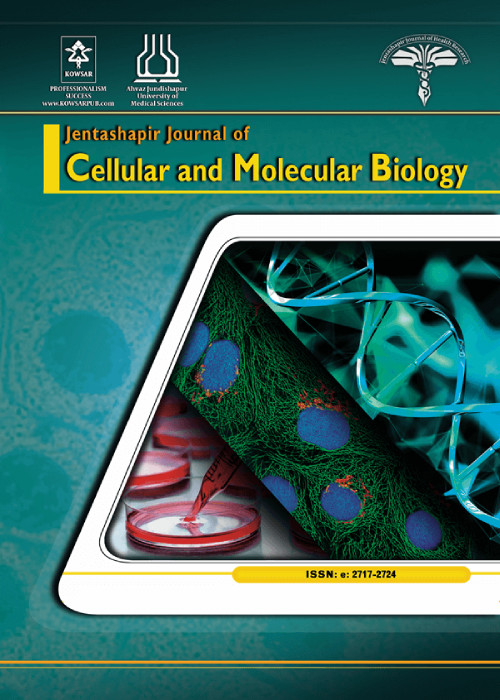فهرست مطالب

Jentashapir Journal of Cellular and Molecular Biology
Volume:12 Issue: 1, Mar 2021
- تاریخ انتشار: 1400/01/14
- تعداد عناوین: 8
-
-
Page 1Background
Canine distemper (CDV) is a highly transmissible serious disease of carnivores. Distemper virus has immunosuppression effects which, in turn, causes opportunistic infections.
ObjectivesThe present study was performed to detect CDV by the genomic and immunological methods and investigate its co-infection with Candida albicans.
MethodsIn this study, from spring of 2018 to winter of 2019, blood, eye, respiratory and digestive system samples were collected from 50 CDV suspected dogs and 50 seemingly healthy dogs. Rapid distemper immunochromatography kit was applied for the primary detection of CDV. RT-PCR and PCR tests were performed using special primers for molecular investigation.
ResultsUsing immunochromatography, twenty-nine cases and one case had positive results for CDV among dogs suspected of having the disease and seemingly healthy dogs, respectively. After RT-PCR and PCR assays, 37 samples were CDV-positive, and four were C. albicans-positive in the first group. While three CDV and one C. albicans-positive samples were found in the second group. In total, the frequency of co-infection was 4%.
ConclusionsIn the present study, there was an association between distemper and C. albicans using statistical tests. Conducting such studies in an appropriate sample population gives more accurate results.
Keywords: Candida albicans, Dog, Distemper, Genomic Investigation, Immunological Detection -
Page 2Background
The association between the human chromosomal 8q24 region and cancer development remains dim. The proto-oncogene MYC is known as the most prominent target of this chromosomal region. However, numerous cancer-associated genetic alterations in the region extend beyond the MYC locus. Accordingly, it is likely that the MYC oncogene is not the only target of these carcinogenesis-related alterations.
ObjectivesIn the present study, the expression of MYC and the correlation between MYC and two non-coding RNAs, namely PVT1 (circular and linear forms) and CASC11, which are residents of the 8q24 region in the MYC neighborhood, were investigated in chronic myeloid leukemia (CML).
MethodsReal-time polymerase chain reaction (PCR) was used to assess BCR-ABL transcripts and categorize positive and negative (normal) samples for CML. Afterward, real-time PCR was exploited to evaluate the expression of different genes, including MYC, linear PVT1, circular PVT (CircPVT1), CASC11, and ACTB in CML and normal samples.
ResultsWe found that the expression of linear PVT1 is significantly increased in CML compared with normal samples. However, CircPVT1, CASC11, and MYC did not show significantly altered expression between CML and normal groups. The experimental and in silico analyses of the correlation coefficients of gene expressions suggested changes in the correlations between the gene expressions in CML compared with normal samples. We also assessed the miR-trapping potential of PVT1 and CASC11 and the possible effects of these interactions on signaling pathways. Our findings indicated that these lncRNAs could have a possible regulatory link with critical pathways associated with leukemogenesis.
ConclusionsOur results indicate that non-coding genes surrounding MYC within the 8q24 region might have regulatory roles in CML carcinogenesis.
Keywords: CML, 8q24, MYC, Non-coding RNAs -
Page 3Background
Male factor infertility that is the cause of about half of the infertility cases, may occur due to azoospermia. Because spermatogenesis defects may lead to non-obstructive azoospermia (NOA), investigating the factors involved in spermatogenesis, including hormones and genes, is one of the most important aspects in understanding the mechanism of NOA in men.
ObjectivesMale infertility is a complex disorder that affects a large proportion of men, yet many of its causes are unknown. Clarifying its genetic basis may help to identify the causes of infertility and provide effective treatment for patients.
MethodsIn this case-control study, single nucleotide polymorphisms (SNPs) located in the USP9Y gene were investigated. Accordingly, 100 healthy men and 100 NOA patients were regarded as control and case groups, respectively. Testis tissue samples were taken during the testicular sperm extraction (TESE) procedure, DNA extraction was done, and ARMS PCR was designed and performed. The rs3212292, rs2032597, rs2032604, rs2032598, and rs717268 polymorphisms in the USP9Y gene were analyzed by Tetra-ARMS PCR. Furthermore, the serum levels of sex hormones were assessed by the ELISA technique. Finally, the obtained data were analyzed by SPSS software.
ResultsAccording to the obtained results, there was no significant difference in case of genotype frequency of investigated SNPs between the case and control groups (P ≥ 0.05). The mean FSH and LH levels in the control group were relatively lower than the case group (P ≤ 0.05), whereas no significant difference in the mean testosterone level was observed between the two groups (P ≥ 0.05).
ConclusionsPolymorphisms of the assessed SNPs showed no effect on the frequency of azoospermia; thus, polymorphisms did not increase the risk of NOA and also did not have a protective effect against the disease. Also, the results showed that the serum levels of FSH and LH increased in NOA patients.
Keywords: Single Nucleotide Polymorphisms, Male Infertility, ARMS PCR, Non-obstructive Azoospermia, USP9Y -
Page 4Background
The lizardfish is an economically important fish in the Persian Gulf with high rates of parasitic infections. Microsporidia species, as opportunistic parasites, cause several disorders, which in turn result in economic problems.
ObjectivesThe main objective was to evaluate Heterosporis sp. infection in Persian Gulf lizardfish using the small subunit ribosomal RNA phylogenetics to describe and classification of the unknown microsporidia species as well as morphological characteristics.
MethodsThe abdominal cavities of fifty specimens of lizardfish, Saurida undosquamis, were examined using morphological and molecular techniques. Some irregular whitish cyst-like were fixed for histopathological and transmission electron observations. The small subunit ribosomal genomic DNA was studied and a 1,279 bp genomic sequence was amplified and investigated for molecular analysis.
ResultsTwenty-two (out of fifty) specimens were infected with irregular whitish microsporidian cysts. Light and electron microscopic findings revealed round cysts containing large numbers of monomorphic and ovoid spores with a posterior vacuole. Polar tube coiled between six and eight-times, in one row. The large xenoma (hypertrophied parasitizing host cells) was encapsulated by a host-derived thick connective tissue in pathological samples. The phylogenetic analysis showed that despite some morphological similarity of the Persian Gulf microsporidia sp. to Glugea spp., the most closely related species with minimum genetic distance to Heterosporis anguillarum isolated is Japanese eels (Anguillajaponica).
ConclusionsThis is the first phylogenetic report of microsporidian infections in mesenteric tissues of lizardfish S. undosquamis in Iran including morphological and molecular markers, to introduce novel species
Keywords: Microsporidian, Lizardfish, Heterosporis, Saurida undosquamis -
Page 5Background
Ovarian cancer is the second leading cause of death in Iran compared with other gynecological diseases. Considering the role of cyclooxygenase (COX) enzymes and prostaglandin E2 production in tumor lesions, nonsteroidal anti-inflammatory drugs (NSAIDs) show antitumor properties by inhibiting COX. Furthermore, some compounds can serve as non-selective inhibitors of COX (such as ketoprofen) and prevent cancer development. Human epididymis protein 4 (HE4) is one of the most sensitive tumor markers known in the study of the disease of ovarian epithelial cancer. The expression of HE4 increases in different types of ovarian cancer.
ObjectivesThe aim of this study was to determine the anti-cancer effects of ketoprofen on the viability of ovarian cancer cells and expression of HE4 gene.
MethodsTo calculate half-maximal inhibitory concentration (IC50), A2780S cells were treated with different concentrations of ketoprofen for 24 hours, then the cells were incubated with appropriate concentrations of IC50 for 24, 48, and 72 hours. Real-time polymerase chain reaction (PCR) was used to measure changes caused by the effect of drugs on HE4 gene expression and analyzed by the 2-ΔΔCT method.
ResultsThe IC50 level of ketoprofen for 24 hours was 583.7 μM. According to real-time PCR results, treatment of cells with ketoprofen reduced HE4 expression.
ConclusionsHE4 gene expression decreased in cells treated with ketoprofen compared with the cells in the control group, which proves the anti-cancer activity of ketoprofen and a reduction in the viability of ovarian cancer cells.
Keywords: Ovarian Cancer, Ketoprofen, A2780S Cell Line, HE4 Gene -
Page 6Introduction
Coronavirus disease 2019 (COVID-19), started in December 2019, affects many organs and systems of the body, such as the central nervous system.
Case PresentationWe describe a case of a 66-year-old female patient with positive results for COVID-19 using real-time PCR (RT-PCR) testing from her cerebrospinal fluid (CSF) and the coronavirus antibodies (Ig G and Ig M) using serology test. Her clinical presentation showed the misbalance and acute weakness of upper and lower limbs with preference of proximal parts of the limbs, pinprick, and the absence of deep tendon reflexes. Taken together, these symptoms, neurological tests and the result of CSF analysis (high protein) were in favor of Guillain-Barre syndrome (GBS). In addition, because the neurological symptoms worsted four days after hospitalization, plasmapheresis was started over the course of 8 days (on every alternate day) with a volume of 2000 mL. Although the results of electromyogram (EMG) - nerve conduction velocity (NCV) following plasmapheresis showed the motor and sensory neuropathy, which was generally accompanied by demyelination, but it leads to the recovery of upper and lower limbs from 2/5 to 4/5 and improvement of neck flexor muscles from 3/5 to 5/5.
ConclusionsGBS should be considered as a neurological outcome of COVID-19. In addition, regarding the beneficial effects of plasmapheresis on GBS (following coronavirus infection), it can be suggested as a part of the treatment protocol in these patients.
Keywords: Plasmapheresis, Central Nervous System, COVID-19, Guillain-Barre Disease -
Page 7Background
Recently, due to the numerous applications of silver nanoparticles (AgNPs) in industry, various routes to synthesize them have been developed.
ObjectivesThe current study was aimed at synthesizing silver nanoparticles by the leaf extract of Berberis vulgaris and evaluating the cytotoxic effects on human breast cancer MCF-7 cell line.
MethodsThe leaf extract of Berberis vulgaris and silver nitrate solution were used to synthesize silver nanoparticles. Ultraviolet (UV)-visible, Fourier-transform infrared, and X-ray diffraction analysis spectroscopy and transmission electron microscopy methods were used to characterize and confirm the nanoparticles’ synthesis. The cytotoxic activity of synthesized nanoparticles (0, 5,10, 20, 40 µg/mL) was also studied by MTT assay.
ResultsThe results showed that Ag nanoparticles were polydisperse and spherical in shape and had a size of about 19.9 nm. Silver nanoparticles reduced the growth of cancerous cells based on time and concentration. The IC50 for MCF-7 cells at 48 hours was 20.27 µg/mL.
ConclusionsThe findings showed that synthesized nanoparticles have an appropriate cytotoxic effect on cancer cells. This impact may be due to the production of free radicals through the release of Ag ions.
Keywords: Silver Nanoparticles, Biosynthesis, Berberis vulgaris, Anticancer Activity


